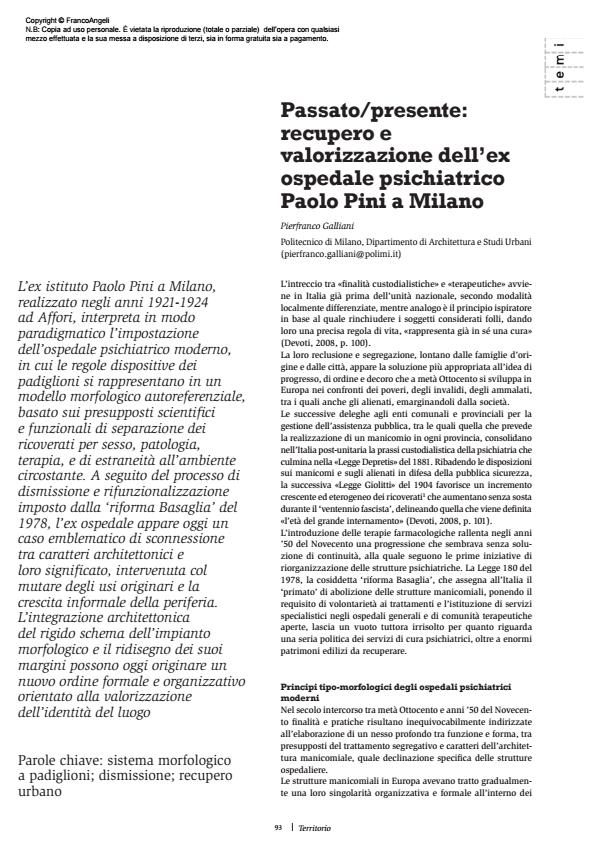Past/present: recovery and reuse of the former Paolo Pini psychiatric hospital in Milan
Journal title TERRITORIO
Author/s Pierfranco Galliani
Publishing Year 2013 Issue 2013/65 Language Italian
Pages 8 P. 93-100 File size 705 KB
DOI 10.3280/TR2013-065015
DOI is like a bar code for intellectual property: to have more infomation
click here
Below, you can see the article first page
If you want to buy this article in PDF format, you can do it, following the instructions to buy download credits

FrancoAngeli is member of Publishers International Linking Association, Inc (PILA), a not-for-profit association which run the CrossRef service enabling links to and from online scholarly content.
The former Paolo Pini hospital in Milan, built between 1921 and 1924 at Affori, is a paradigmatic interpretation of the design of a modern psychiatric hospital, in which the rules governing the spatial distribution of the pavilions consisted of a selfreferencing morphological model, based on the scientific and spatial assumptions of separating patients, by gender, disease and treatment and of isolating them from the surrounding environment. Following the process of abandonment and reuse imposed by the 1978 ‘Basaglia Reform’, today the former hospital is an emblematic example of the delinking of architectural features and their meaning, which occurred with the change of the original uses and the informal growth of the outer city area. The architectural integration of the rigid morphological layout and the redesign of its borders are able today to give rise to a new formal and organisational order designed to enhance the identity of the place.
Keywords: Pavilion based morphological system; abandonment; urban recovery
- Aa.Vv., s.d., Museo d’Arte Paolo Pini. Collezione permanente, Azienda Ospedaliera Niguarda Ca’ Granda, Milano.
- Alessandrini M., 2002, Immagini della follia. La follia nell’arte figurativa, Edizioni Magi, Roma.
- Bedoni G., Tosatti B., 2000, a cura di, Arte e psichiatria. Uno sguardo sottile, Mazzotta, Milano.
- Galzigna M., 2007, a cura di, Museo del manicomio di San Servolo. La follia reclusa, Arsenale Editrice, Venezia.
- Jaspers K., 1922, Strindberg und Van Gogh, s.e., s.l. (trad. it., 1990, Genio e follia: Strindberg, Van Gogh, Swedenborg, Hölderlin, Rusconi, Milano).
- Melorio T., Baccei E., 2009, «Arte e psiche: il Museo d’Arte Paolo Pini e le botteghe d’arte», in Crippa M. A., Sironi V.A. (a cura di), Niguarda: un ospedale per l’uomo nel nuovo millennio. Arte e storia della cura alla Ca’ Granda di Milano, Silvana Editoriale, Cinisello Balsamo.
- Vanzan Marchini N. E., 2004, San Servolo e Venezia: un’isola e la sua storia, Cierre, Sommacampagna.
Pierfranco Galliani, Passato/presente: recupero e valorizzazione dell’ex ospedale psichiatrico Paolo Pini a Milano in "TERRITORIO" 65/2013, pp 93-100, DOI: 10.3280/TR2013-065015